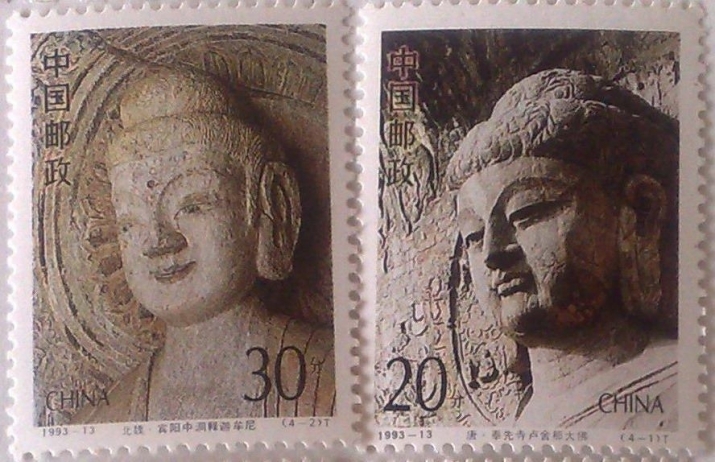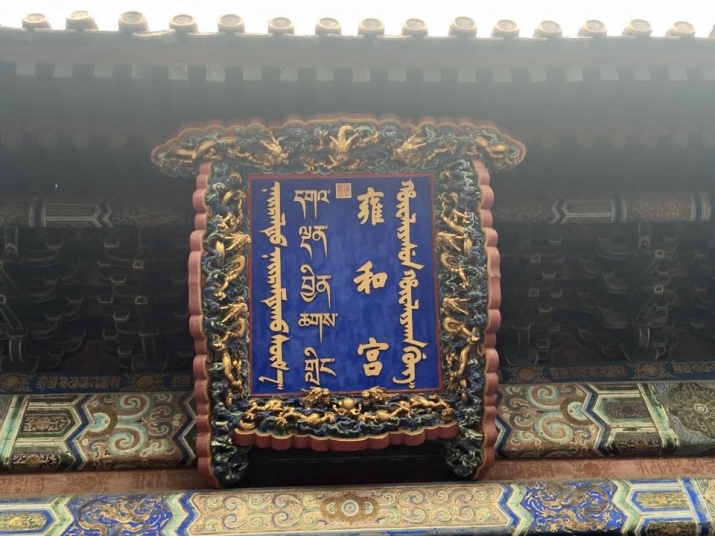FEATURES|THEMES|Commentary
Buddhistdoor View: Mahayana Buddhism’s Unique Place in History and Chinese Civilization
 Chinese stamps of Shakyamuni Buddha in the Middle Binyang Cave and Vairocana Buddha in the Fengxian Cave at the Longmen Grottoes. From Master Jingzong Facebook
Chinese stamps of Shakyamuni Buddha in the Middle Binyang Cave and Vairocana Buddha in the Fengxian Cave at the Longmen Grottoes. From Master Jingzong FacebookPristine Pure Land teacher Master Jingzong (b. 1966) once wrote about why he would not want to be born anywhere else except in China: “For all its faults, China would still be the place where I would choose to be reborn in my next life, if I were free to decide . . . there is one overriding justification: the people in this country have extraordinarily profound karmic connections with Amitabha Buddha. By reciting the name of the Buddha, countless sentient beings in China were reborn in the Pure Land in the past. This will continue to be the case now and in the future,” he wrote. “As for me, since I admire Amitabha-reciters, my affection extends to the country with deep-rooted karmic intimacy with Amitabha and its culture.” (Master Jingzong Facebook)
China faces numerous challenges, from grand and grave matters of statecraft and national destiny to, as Master Jingzong highlighted, the precious things in life: blue skies, lush greenery, fresh air, safe drinking water, and freedom. Yet these are minor concerns compared with the spiritual fullness and abundance of Amitabha-reciters. Of course, many other Asian countries, from Thailand to Mongolia, are fortunate and auspicious for having Buddhism diffused into their cultures, while Western countries have been doubly blessed with unique tools to interact with the recent but significant seeds of Buddhism planted in their cultures.
Implicit within Master Jingzong’s words is the idea that Pure Land Buddhism has unique characteristics that have made China the ideal place in which to be reborn. These characteristics—the Chinese expression of Buddhism—can be said to be simplicity of approach and an unfussy, unclutteredness of practice, an emphasis on the universality of Buddhahood, and a hearty embrace of Buddhism as a religion of life and relationships. Other Dharma movements in China, such as the schools of Chan and various expressions of humanistic Buddhism, share these marks to varying degrees.
Buddhism has enjoyed a long presence in China since the time of the courtly translators sojourning in the Han capital of Luoyang, the earliest being Lokaksema of the Kushana Empire (b. 147 CE) and An Shigao of Parthia (fl. c. 148–80 CE). Over the course of this long history, Buddhism has influenced China’s literature (most notably High Tang poetry and grand works of fiction such as Journey to the West and Dream of the Red Chamber), society, and even ways of thinking and everyday expression. Even non-Buddhist Chinese use the term yin guo— which is translated as karma or karmic fruition—in common parlance for completely secular concerns.
Chinese Buddhism is at once cosmic and transcendental (thanks especially to the influence of the Avatamsaka Sutra) yet down-to-earth, almost pragmatic. It can discuss in profound ways a bodhisattva’s literal vision of the universe, then move on to a discourse on human anecdotes about the Pure Land or the nature of insight. It invokes dynasties past and lessons learned in the same breath as a reading about caring for emotional problems and neuroses in the country’s sprawling coastal cities. With some exceptions in the esoteric traditions, it is practiced without a sense of existential dependence on a teacher, even though students love and respect their preceptors dearly.
In this sense, Chinese Buddhism, for all its philosophical and hermeneutic diversity, is remarkably unified and ecumenical in spirit. And contrary to stereotypes, the esoteric traditions, though they might be a minority and not as influential as they were (certainly during the Tang Dynasty (618–907)), are actively contributing to the life of Chinese Buddhism.
 The paibian (temple sign) of Yonghe Temple in Beijing, built in 1694 and converted into a temple in 1722 by the Yongzheng Emperor and an excellent example of Buddhism's ability to speak to many cultures (Manchu, Han Chinese, Mongolian, and Tibetan) of the then-Qing empire. From buddhistdoor.net
The paibian (temple sign) of Yonghe Temple in Beijing, built in 1694 and converted into a temple in 1722 by the Yongzheng Emperor and an excellent example of Buddhism's ability to speak to many cultures (Manchu, Han Chinese, Mongolian, and Tibetan) of the then-Qing empire. From buddhistdoor.netFrom a historical perspective, the Sinicization of Buddhism effectively preserved the Mahayana tradition after its decimation in medieval India. China provided Buddhism with an adopted home from which to develop new social, cultural, and intellectual roots. The Chinese stronghold absorbed influences from Central Asia and India and, through the long process of understanding and propagating this once-foreign faith, catapulted it into the East Asian civilizational orbit, which included eventual Buddhist heavyweights such as Korea and Japan. The encounter between Chinese civilization and the Buddhist diffusion was therefore a critical juncture in human history for Buddhism as well as China.
Today, it should be fair to say that mainstream Chinese Buddhist schools see themselves as indispensable components of the national story. An even better way of conceiving of the tradition might be to see it as a karmically auspicious and serendipitous cultural adoption of Mahayana Buddhism. The phenomenon of Chinese Buddhism can be summed up as an ancient civilization’s assimilation of the bodhisattvayana, which in hindsight was critical to the latter’s endurance beyond India and Central Asia, regions that largely lost their Buddhist heritage and have only recently begun to remember. Without this meeting, without either to complement the other, both China and Buddhism would have been unimaginably impoverished.
What is the yin guo of Chinese Buddhism in today’s world? Time will tell, although developments, taken as a whole, give reason for cautious optimism. The story of Buddhism in China is diverse, multifaceted, and hard to summarize. Perhaps it is more accurate to speak of many stories. What could be more confidently said is that it is almost impossible to think of China today without the spiritual mentorship of Buddhism, or a Mahayana Buddhism that was not nurtured in the bosom of old China. The yin guo of the two, no matter how apparently distant or unrelated, are therefore intertwined.
See More
Happy to Be Born in China (Master Jingzong Facebook)














